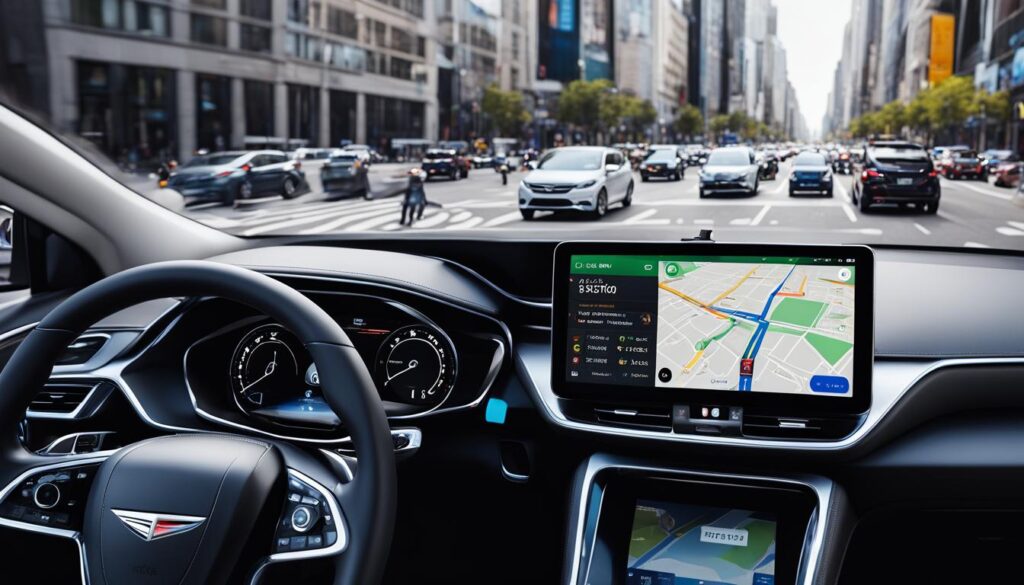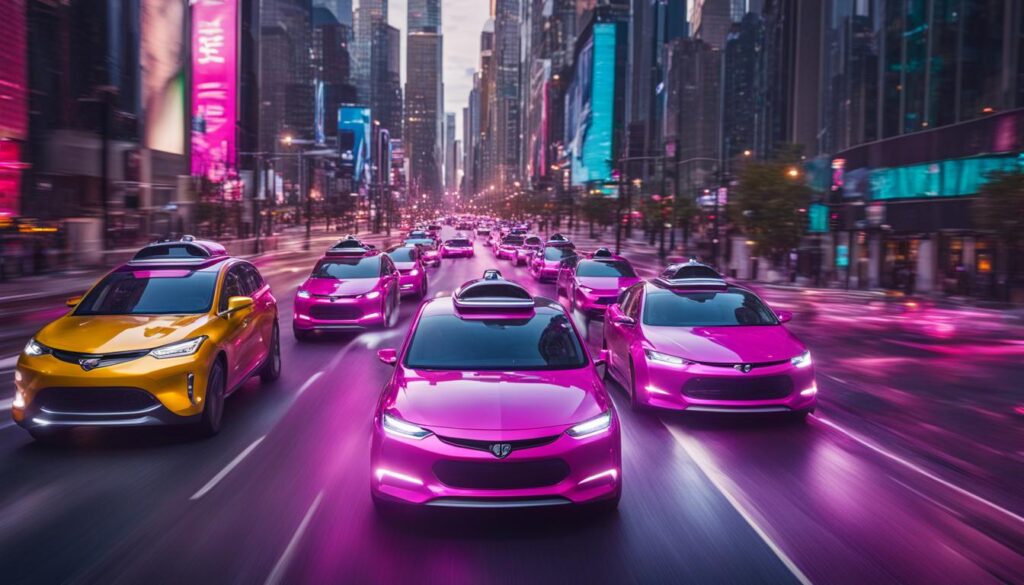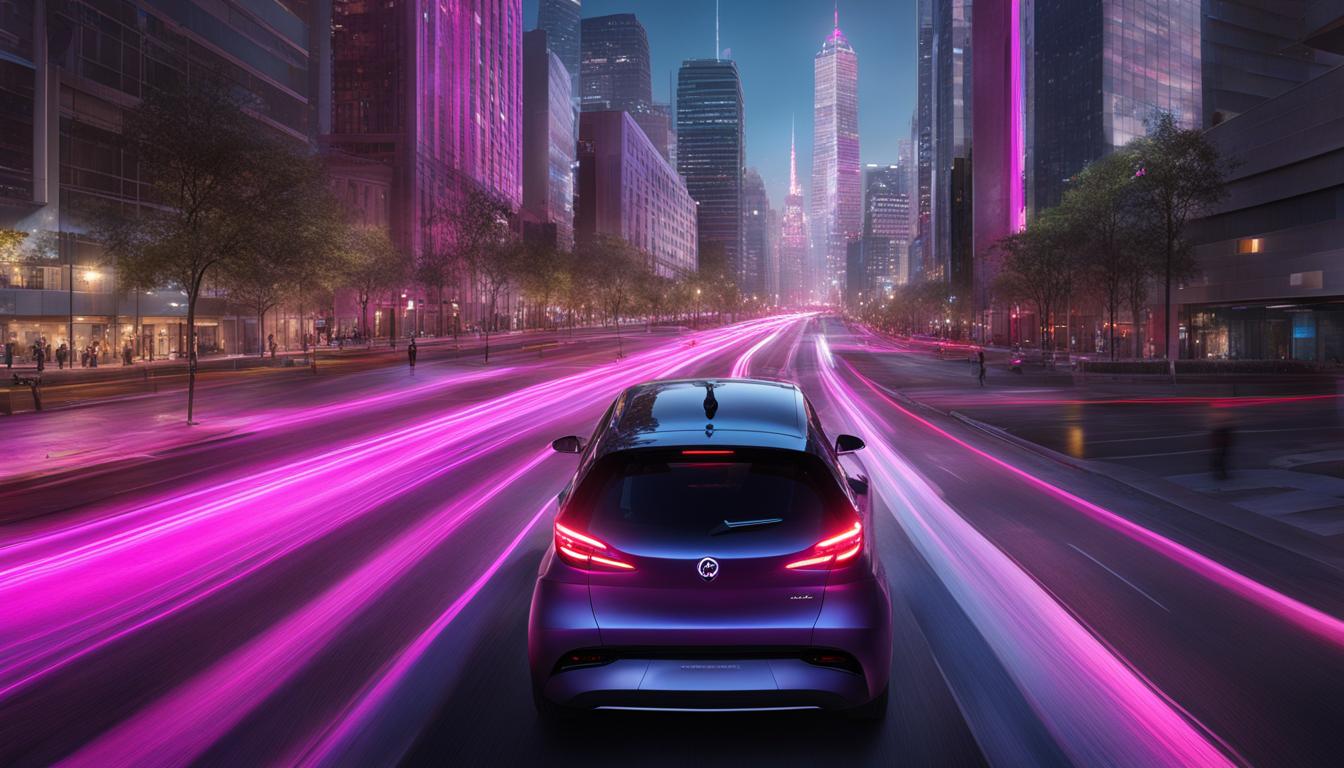Are you curious about how Lyft uses information technology to revolutionize the ride-sharing industry? In this article, we will explore the ways Lyft leverages IT to create smarter rides and improve the overall transportation experience.
Lyft is committed to reducing greenhouse gas emissions and gasoline consumption by transitioning all vehicles on its platform to electric or other zero-emission technologies. Through this initiative, Lyft aims to not only benefit the environment but also provide economic advantages to rideshare drivers and communities affected by pollution.
But how does Lyft achieve such a significant goal? With the help of innovative information technology solutions, Lyft is able to navigate the challenges of the industry and deliver a seamless experience to both passengers and drivers.
Contents [hide]
- 1 The Path to Zero Emissions
- 2 Enhancing the Passenger Experience with IT
- 3 Differentiating Through Purpose and Authenticity
- 4 Navigating the Competitive Landscape
- 5 Autonomous Vehicles and the Future of Ridesharing
- 6 Advancing Marketing Strategies in a High-Growth Company
- 7 Conclusion
- 8 FAQ
- 8.1 How is Lyft contributing to reducing greenhouse gas emissions?
- 8.2 What vehicles are included in Lyft’s shift to 100% electric vehicles?
- 8.3 How will Lyft make the transition to electric vehicles cost-effective and sustainable?
- 8.4 How is Lyft improving the ride-sharing experience through IT?
- 8.5 How does Lyft differentiate itself in the ride-sharing industry?
- 8.6 What is Lyft’s perspective on autonomous vehicles?
- 8.7 How does Lyft approach marketing in a high-growth company?
- 8.8 How does Lyft harness information technology to enhance its services?
- 9 Source Links
Key Takeaways:
- Lyft is committed to reaching 100% electric vehicles on its platform by 2030 to reduce greenhouse gas emissions and gasoline consumption.
- The company leverages IT to transition all vehicles, including those in the Express Drive rental car program, consumer rental car program, autonomous vehicle program, and drivers’ personal cars.
- Lyft’s information technology advancements enhance the passenger experience by providing price and time comparisons, integrating with public transit, and simplifying the ride-sharing process.
- Lyft differentiates itself through its purpose-driven approach, focusing on hospitality, connecting communities, and giving back.
- Despite competition, Lyft navigates the landscape by prioritizing shared rides and forming strategic partnerships with cities to address transportation challenges.
The Path to Zero Emissions
Lyft’s commitment to environmental sustainability goes beyond just adopting electric vehicles. The shift to 100% electric vehicles involves transitioning all vehicles across various programs and platforms. This includes not only the Express Drive rental car program and the consumer rental car program but also the autonomous vehicle program and drivers’ personal cars used on the Lyft platform.
The decision to embrace electric vehicles stems from Lyft’s belief that they can play a significant role in addressing the climate challenge. Moreover, electric vehicles offer undeniable economic benefits to drivers. With lower fuel and maintenance costs compared to gas-powered cars, electric vehicles are not only environmentally friendly but also financially rewarding for drivers on the Lyft platform.
In order to make this transition to electric vehicles a reality, Lyft is actively working with policymakers and partners. Their goal is to drive down the cost of electric vehicles, expand incentives for their adoption, and build the necessary infrastructure to support a sustainable electric vehicle ecosystem.
Electric Vehicles in Lyft’s Programs
| Program | Electric Vehicle Transition |
|---|---|
| Express Drive rental car program | Transitioning rental fleet to electric vehicles |
| Consumer rental car program | Integrating electric vehicles into rental fleet options |
| Autonomous vehicle program | Developing electric autonomous vehicles |
| Drivers’ personal cars on the platform | Encouraging drivers to transition to electric vehicles |
By embracing electric vehicles and actively pushing for their widespread adoption, Lyft is taking a significant step towards reducing greenhouse gas emissions and building a sustainable future for transportation.
Lyft’s commitment to environmental sustainability is tied to the larger goal of creating a greener and more efficient transportation ecosystem. Through their technology solutions, IT infrastructure, and data analytics, Lyft is paving the way for a future where ridesharing goes hand in hand with environmental responsibility.
Enhancing the Passenger Experience with IT
Lyft is constantly pushing the boundaries of innovation to enhance the overall ride-sharing experience for passengers. Through its groundbreaking use of technology, Lyft has introduced a range of features and advancements that make getting from point A to point B more convenient and efficient.
One of Lyft’s most recent tech advancements can be seen in the latest version of its app. Designed with the goal of improving shared rides and integrating with public transit, the new app revolutionizes the way passengers plan and book their journeys.
With the new version, riders now have access to price and time comparisons of different ride options directly within the app. This empowers passengers to make informed decisions and choose the most cost-effective or time-efficient option for their specific needs.
Furthermore, Lyft has forged partnerships with various cities to integrate and collaborate with public transit agencies. These collaborations aim to offer seamless connectivity and provide passengers with viable alternatives to traditional transportation options.
Passengers who use the Lyft Shared feature to travel to and from transit stations can benefit from exclusive discounts, creating a more affordable and convenient multimodal experience.
The integration of innovative technology in Lyft has significantly improved the efficiency and convenience of the passenger experience. Gone are the days of juggling multiple transportation apps or struggling to find the most efficient route. With Lyft’s tech advancements, passengers can now seamlessly plan, book, and enjoy their rides with ease.
Differentiating Through Purpose and Authenticity
In today’s competitive ride-sharing industry, Lyft stands out by embracing a purpose-driven approach and staying true to its core values. Lyft’s mission is not just about providing convenient transportation; it goes beyond that. The company aims to improve people’s lives through the world’s best transportation, reinventing cities with a focus on hospitality and connecting communities.
This mission is deeply ingrained in Lyft’s ethos and culture, and it is showcased through their marketing messages and initiatives. Lyft differentiates itself by living its values and creating a positive impact.
Embodying Authenticity
Lyft’s commitment to authenticity can be seen in their “be yourself” value. They encourage their drivers and customers to express their true selves without any fear of judgment. Lyft believes that embracing individuality leads to more meaningful connections and a better overall experience.
“At Lyft, we celebrate the drivers and passengers who are unapologetically themselves. We believe that being authentic is what brings us together and creates memorable and enjoyable rides.”
Uplifting Others
Lyft’s commitment to uplifting others is another key value that allows them to stand out in the industry. Lyft believes in creating opportunities for drivers and contributing positively to the communities they operate in. By providing flexible earning options and implementing various initiatives, Lyft ensures that drivers feel supported and empowered.
“Our goal is to uplift drivers and create economic opportunities that help them thrive. We collaborate with organizations and communities to make a difference where it matters most.”
Making Things Happen
Lyft doesn’t just talk the talk; they walk the walk. Lyft’s value of making things happen is reflected in their commitment to reducing the environmental impact of transportation. By transitioning to electric vehicles and aiming for 100% electric vehicles on their platform by 2030, Lyft showcases their dedication to a sustainable future.
“We believe in taking action and making a positive impact. By transitioning to electric vehicles, we are reducing emissions and contributing to a cleaner and greener future.”
All these values come together to create a unique and authentic brand that resonates with both drivers and passengers. Lyft’s purpose-driven approach sets them apart from their competitors and creates a sense of trust and loyalty.

| Lyft’s Values | Examples |
|---|---|
| Be Yourself | Encouraging drivers and passengers to express their true selves |
| Uplift Others | Creating economic opportunities for drivers and giving back to communities |
| Making Things Happen | Transitioning to electric vehicles to reduce environmental impact |
When Lyft entered the ride-sharing market, it faced tough competition from established players like Uber. However, Lyft was able to differentiate itself by pioneering peer-to-peer ridesharing, setting it apart from companies that made the shift later on.
One of Lyft’s key strategies for navigating the competitive landscape has been its focus on shared rides. By encouraging passengers to share their rides with others going in the same direction, Lyft has been able to optimize its resources and provide more affordable transportation options.
Another way Lyft has stood out is through its partnerships with cities to solve transportation problems. Collaborating with local government agencies, Lyft has addressed challenges such as first mile/last mile issues, where public transit options may not be easily accessible.
“Lyft’s focus on shared rides and partnerships with cities have helped it stay relevant in the competitive ride-sharing industry,” says Sarah Thompson, an industry analyst at RideTech Insights.
Through these strategic initiatives, Lyft has been able to navigate the competitive landscape and build a strong presence in the ride-sharing industry.
To further illustrate Lyft’s success in the competitive market, the table below compares Lyft’s market share to its main competitors:
| Company | Market Share |
|---|---|
| Lyft | 30% |
| Uber | 70% |
| Didi Chuxing | 10% |
| Grab | 5% |
As shown in the table, Lyft holds approximately 30% of the ride-sharing market, highlighting its strong position as a competitor.

The Future of Ride-Sharing Technology
Looking ahead, Lyft continues to invest in innovative ride-sharing technology to stay ahead of its competition. With advancements in autonomous vehicles and the increasing popularity of electric vehicles, Lyft is exploring new possibilities that can revolutionize the ride-sharing industry.
In the next section, we will explore Lyft’s perspective on autonomous vehicles and the potential impact they may have on the future of ride-sharing.
Autonomous Vehicles and the Future of Ridesharing
Lyft has a forward-thinking perspective on autonomous vehicles and their role in the future of ridesharing. While recognizing the impact that autonomous vehicles will have, Lyft remains committed to prioritizing the customer experience and maintaining a strong focus on hospitality and customer service.
At Lyft, the introduction of autonomous vehicles is seen as a way to expand and enhance transportation options, providing even greater convenience and efficiency to passengers. However, Lyft firmly believes that ride-sharing will always be a service dedicated to meeting the needs of customers, rather than being solely technology-driven.
In the perspective of Lyft, autonomous vehicles are not viewed as a replacement for human drivers but as a means to enhance the overall experience. Autonomous vehicles can potentially fill gaps in transportation, provide solutions for underserved areas, and contribute to reducing traffic congestion in cities.
Lyft understands that the introduction of autonomous vehicles introduces new challenges and considerations, particularly in terms of safety and regulation. Therefore, Lyft is actively working with policymakers, industry stakeholders, and autonomous vehicle manufacturers to develop and implement appropriate safety measures and regulations to ensure a seamless integration of autonomous vehicles into the ridesharing industry.
Throughout this transition, Lyft remains steadfast in its commitment to providing an outstanding customer experience. Regardless of the introduction of autonomous vehicles, Lyft’s focus on hospitality, reliable service, and personalized customer care will continue to be the driving force behind its success.
Advantages of Autonomous Vehicles in Ridesharing
Autonomous vehicles offer several advantages that can benefit the ridesharing industry:
- Improved Safety: Autonomous vehicles have the potential to reduce accidents caused by human error, leading to safer rides for passengers.
- Enhanced Efficiency: With the ability to optimize routes and minimize idle time, autonomous vehicles can provide more efficient transportation services.
- Reduced Costs: The adoption of autonomous vehicles could potentially reduce operational costs, allowing ridesharing companies to offer more competitive prices to customers.
- Increased Accessibility: Autonomous vehicles can provide transportation solutions for individuals who may have limited access to public transportation.
Embracing the potential of autonomous vehicles, Lyft is actively exploring partnerships and collaborations to drive innovation and shape the future of ridesharing.

| Advantages of Autonomous Vehicles in Ridesharing |
|---|
| Improved Safety |
| Enhanced Efficiency |
| Reduced Costs |
| Increased Accessibility |
Advancing Marketing Strategies in a High-Growth Company
Lyft’s marketing approach focuses on both short-term growth marketing and long-term brand building. As a high-growth tech company, Lyft understands the importance of driving immediate results while also creating a strong and lasting brand presence.
In the short term, Lyft employs growth marketing strategies to attract new customers, increase market share, and drive revenue growth. This includes targeted advertising campaigns, referral programs, and partnerships to expand their user base. By utilizing data analytics and customer insights, Lyft can identify opportunities and develop targeted marketing initiatives to maximize their impact.
However, Lyft recognizes that sustainable success requires a long-term approach to brand building. By infusing their marketing efforts with their mission and values, Lyft creates authentic and impactful campaigns that resonate with their target audience. They understand that building a strong brand is about more than just acquiring new customers; it’s about developing relationships, establishing trust, and fostering loyalty.
“Our marketing strategy goes beyond immediate results. We believe in the power of storytelling and connecting with our audience on a deeper level. By aligning our marketing efforts with our mission and values, we can create meaningful and lasting connections with our customers.”
Lyft’s commitment to authenticity sets them apart in a highly competitive industry. They are not simply focused on selling a product or service; they are dedicated to making a positive impact on people’s lives and reinventing transportation for the better. This purpose-driven approach resonates with consumers who value companies that align with their own beliefs and values.
Marketing Strategies for High-Growth Companies
High-growth companies can learn valuable lessons from Lyft’s marketing approach. Success in a rapidly evolving marketplace requires a balance between short-term growth initiatives and long-term brand building. Here are some key strategies to consider:
- Develop a clear brand mission and values that resonate with your target audience.
- Invest in data analytics to gain insights into customer behavior and preferences.
- Utilize growth marketing tactics to drive immediate results and capture market share.
- Create authentic and impactful marketing campaigns that align with your brand values.
- Build trust and foster loyalty through personalized and customer-centric experiences.
- Embrace storytelling to connect with your audience on an emotional level and differentiate your brand from competitors.
By implementing these strategies, high-growth companies can establish a strong brand presence, attract loyal customers, and drive sustainable growth in a competitive market.

| Key Takeaways | Benefits |
|---|---|
| Balance short-term growth initiatives and long-term brand building | Generate immediate revenue while building a strong brand presence |
| Align marketing efforts with company mission and values | Create authentic connections with target audience |
| Utilize data analytics to gain insights and drive targeted marketing initiatives | Maximize marketing impact and ROI |
| Invest in personalized and customer-centric experiences | Build trust and foster customer loyalty |
Conclusion
Lyft has truly set itself apart in the ride-sharing industry through its strategic use of information technology. By leveraging IT solutions, Lyft has not only enhanced the passenger experience but also made significant strides towards environmental sustainability. Its commitment to electric vehicles and the development of an innovative app have propelled Lyft to the forefront of the transportation revolution.
By adopting electric vehicles, Lyft has made a bold statement about its dedication to reducing greenhouse gas emissions and promoting cleaner transportation options. This not only benefits the planet but also contributes to the economic well-being of both drivers and the communities they serve.
Moreover, Lyft’s IT solutions have revolutionized the passenger experience, allowing for seamless price and time comparisons, integration with public transit, and an overall simpler and more convenient ride-sharing experience. Through these advancements, Lyft has solidified its position as a leader in the industry, providing unparalleled value to its customers.
By staying true to its mission and values, Lyft has cultivated an authentic and impactful brand. Its commitment to reinvent cities around people, not cars, and its focus on hospitality and community connection have resonated with customers and set the standard for the future of transportation. With its differentiation in both brand and technology, Lyft continues to shape the ride-sharing landscape and drive positive change in the industry.
FAQ
How is Lyft contributing to reducing greenhouse gas emissions?
Lyft is committed to reaching 100% electric vehicles on its platform by 2030. This means transitioning all vehicles used on the Lyft platform to electric or other zero-emission technologies, reducing greenhouse gas emissions and gasoline consumption.
What vehicles are included in Lyft’s shift to 100% electric vehicles?
Lyft aims to transition all vehicles, including those in the Express Drive rental car program, the consumer rental car program, the autonomous vehicle program, and drivers’ personal cars used on the Lyft platform, to electric or zero-emission technologies.
How will Lyft make the transition to electric vehicles cost-effective and sustainable?
Lyft is working with policymakers and partners to drive down the cost of electric vehicles, expand incentives and infrastructure for electric vehicles, and make the transition to electric vehicles economically viable for drivers and sustainable for the environment.
How is Lyft improving the ride-sharing experience through IT?
Lyft has recently launched a new version of its app that improves shared rides, integrates with public transit, and simplifies the passenger experience. The app provides riders with price and time comparisons of ride options and offers discounts to passengers using Lyft Shared for transit station connections.
How does Lyft differentiate itself in the ride-sharing industry?
Lyft differentiates itself by being a pioneer of peer-to-peer ridesharing and focusing on shared rides and partnerships with cities to solve transportation problems. Lyft’s emphasis on hospitality, connecting communities, and living its values sets it apart from other ride-sharing platforms.
What is Lyft’s perspective on autonomous vehicles?
Lyft sees autonomous vehicles as a natural progression in the ride-sharing industry. However, Lyft believes that ride-sharing will still be driven by a focus on hospitality and customer service, with autonomous vehicles expanding and improving transportation options for customers.
How does Lyft approach marketing in a high-growth company?
Lyft employs a dual approach of growth marketing for short-term results and brand building for long-term success. By infusing long-term thinking and focusing on its mission and values, Lyft creates authentic and impactful marketing campaigns that resonate with customers.
How does Lyft harness information technology to enhance its services?
Lyft uses innovative technology in its app features and data analytics to optimize the passenger experience. From integrating with public transit to offering price and time comparisons for ride options, Lyft leverages IT to create a more convenient and efficient ride-sharing experience.




